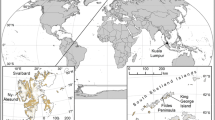Abstract
Acid and alkaline phosphatase activities were evaluated using batch fermenter cultues ofPenicillium citrinum, an organism used in studies of fungal functioning in soil. Fungal activity was assessed by monitoring rates of O2 utilization, glucose utilization, dry weight changes over time, and lengths of FDA-stained hyphae. At low growth rates (7 μg dry wt increases·h−1·ml−1) and low culture activity, phosphatase activity at both pH 8.5 and 5.5 tended to decrease with culture age, with the exception that phosphatase activity at pH 8.5 peaked during early stationary phase. At higher growth rates (25 μg dry wt increase·h−1·ml−1) and high culture activity, phosphatase activity tended to remain constant throughout the course of the experiment. The relationship between phosphatase activity and other measures of fungal activity was consistent only at low growth rates for acid phosphatase. These results suggest that phosphatase measurements will be of limited utility in assessing activity, except at low growth rates.
Similar content being viewed by others
Literature cited
Anderson J P E and Domsch K H 1980 Quantities of plant nutrients in the microbial biomass of selected soils. Soil Sci. 130, 211–216.
APHA-AWWA-WPCF 1971 Standards Methods for the Examination of Water and Wastewater, 13th ed. American Public Health Association, Washington, D.C.
Burns D J W and Beever R E 1979 Mechanism controlling the two phosphate uptake systems inNeurospora crassa. J. Bacteriol. 139, 195–204.
Brown D E 1970 Aeration in the submerged culture of microorganisms. Meth. Microbiol. 2, 125–174.
Calam C T 1969 Culture of Microorganisms in Liquid Medium.In Meth. Microbiol. 1, 250–285.
Cooper C M, Fernstrom G A and Miller S A 1944 Performance of agitated gas-liquid contractors. Ind. Eng. Chem. 36, 504–509.
Domsch K H, Beck T, Anderson J P E, Söderström B, Parkinson D and Trolldenier G 1979 A comparison of methods for soil microbial population and biomass studies. Z. Pflanzenernaehr. Bodenkd. 142, 520–533.
Dubois M, Gilles K A, Hamilton J K, Rebers P A and Smith F 1956 Colorimetric method for determination of sugars and related substances. Anal. Chem. 28, 350–356.
Gould W D, Coleman D C and Rubink A J 1979 Effect of bacteria and amoebae on rhizosphere phosphatase activity. Appl. Environ. Microbiol. 37, 943–946.
Greenman J and Melville T H 1979 The influence of certain growth conditions on the phosphatase activity ofStreptococcus mutans grown in batch and continuous culture. Microbios 21, 23–32.
Hersman L E and Temple K L 1979 Comparison of ATP, Phosphatase, pectinolyase and respiration as indicators of microbial activity in reclaimed coal strip mine spoils. Soil Sci. 127, 70–73.
Hughes D E and Wimpenny J W T 1969 Oxygen metabolism by microorganisms. Adv. Microb. Physiol. 3, 197–232.
Ingham E R and Klein D A 1982 Relationship between fluorescein diacetate-stained hyphae and oxygen utilization, glucose utilization and biomass of submerged fungal batch culture. Appl. Environ. Microbiol. 44, 363–370.
Ingham E R and Klein D H 1984 Soil fungi relationship between FDA staining and fungal activity. Soil Biol. Biochem (In press).
Nagasaki S 1968 Physiological aspects of various enzyme activities in relation to the culture age ofAspergillus niger mycelia. J. Gen. Appl. Microbiol. 14, 147–161.
Nannipieri P, Pedrazzini F, Arcara P G, and Piovanelli C 1979 Changes in amino acids, enzyme activities, and biomasses during soil microbial growth. Soil Sci. 127, 26–34.
O'Neill R V and Reichle D E 1980 Dimensions of Ecosystem Theory.In 40th Biology Colloquium. Ed. R H Waring, Oregon State Univ. Press, Corvallis.
Parkinson D, Gray T R G and Williams S T 1971 Methods for studying the ecology of soil microorganisms. IBP Handbk. # 19. Blackwell Scientific Publications, Oxford, England.
Raper K B and Thom C 1949 A Manual for Penicillia. Tindall and Cox, London.
Skujins J 1976 Extracellular enzymes in soil. CRC Crit. Rev. Microbiol. 4, 383–421.
Söderström B E 1977 Vital staining of fungi in pure culture and in soil with fluorescein diacetate. Soil Biol. Biochem. 9, 59–63.
Tabatabai M A and Bremner J M 1969 Use of p-nitrophenyl phosphate for assay of soil phosphatase activity. Soil Biol. Biochem. 1, 301–307.
Author information
Authors and Affiliations
Rights and permissions
About this article
Cite this article
Ingham, E.R., Klein, D.A. Phosphatase activity ofPenicillium citrinum submerged batch cultures and its relationship to fungal activity. Plant Soil 81, 61–68 (1984). https://doi.org/10.1007/BF02206894
Received:
Issue Date:
DOI: https://doi.org/10.1007/BF02206894




